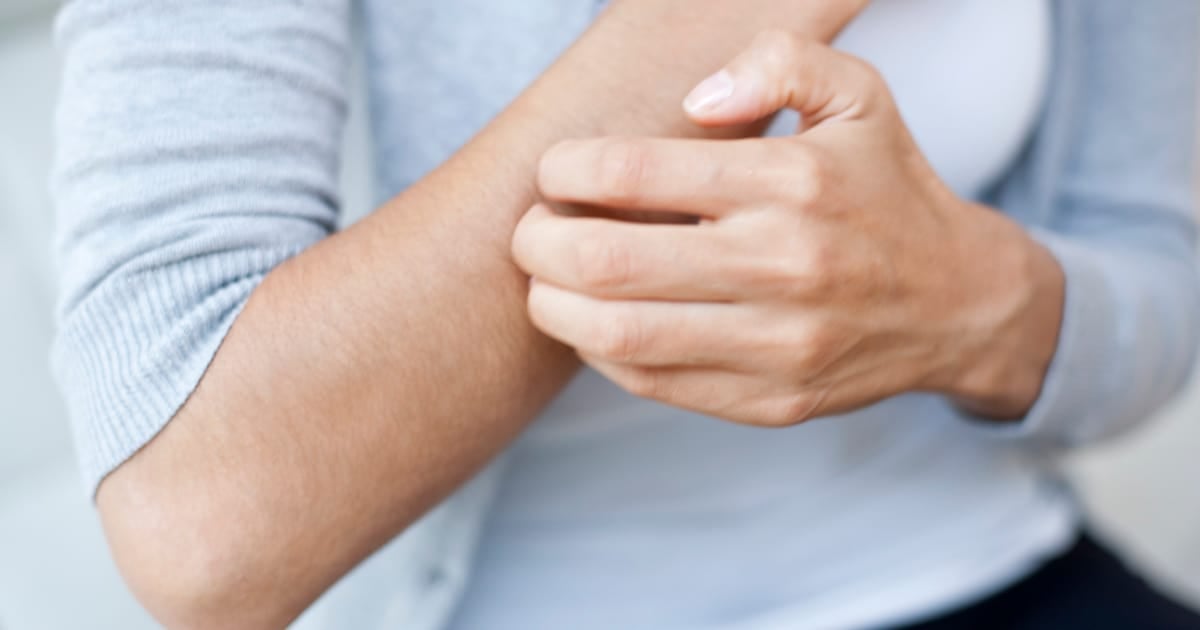As if you didn’t have enough on your diabetes to-do list, you’ll want to add healthy skincare to the list to prevent the most common diabetes skin problems.
In the same way that high blood sugar levels can damage blood vessels in your fingers, toes, eyes, and organs–they can lead to some mild-to-major issues within your skin, too.
In this article, you’ll learn about the most common diabetes skin problems, how they are treated, and what steps you can take to keep your skin healthy as a person with diabetes.

Common diabetes skin problems
These skin issues should be taken seriously. Even seemingly simple color changes in your skin may look harmless but could indicate something more significant is developing.
For some, a referral to a dermatologist can actually lead to a person’s initial diabetes diagnosis, because skin issues are one of the earliest signs that develop, particularly in those with undiagnosed type 2 diabetes.
“Diabetes can cause several types of skin problems,” explained Michele S. Green, MD, and dermatologist from Lenox Hill Hospital in New York City. The majority, she adds, are preventable with healthy blood sugar management. And fortunately, many of them can be eased or entirely fixed with healthy blood sugar management.
Don’t hesitate to contact your doctor or visit an urgent care clinic if you suspect you may be experiencing symptoms similar to any of these skin issues.
Itching
“Often caused by poor circulation and excessively dry skin in people with diabetes,” explains Green.
How it’s treated: While some itching is part of another skin condition listed below, the American Diabetes Association (ADA) says it can often be treated easily if it’s just the result of poor circulation and dryness.
In addition to improving your overall blood sugar levels, the ADA recommends limiting how often you bathe–because baths tend to dry your skin further, increasing the itchiness. When you do bathe, use mild fragrance-free soap and apply plenty of fragrance-free moisturizer after every bath.
Necrobiosis Lipoidica
“This is a disease caused by changes in the blood vessel health which appear as a dull, red raised area that can be itchy and painful,” explains Green.
How it’s treated: While very rare, the ADA says women are more prone to this condition.
“As long as the sores do not break open, you do not need to have it treated.” If the sores do open, contact your doctor or visit urgent care quickly.
Diabetic Dermopathy
“This condition appears as a brown, scaly patch similar in appearance to an ‘age spot’, and it’s caused by changes in the small blood vessels beneath the skin,” explains Green.
How it’s treated: This condition is harmless and does not need treatment. However, improving overall blood sugar levels can prevent it from getting worse.
Bullosis Diabeticorum (diabetic blisters)
“Blisters that look like ‘burn blisters’ primarily affect people with diabetic neuropathy. These blisters are often large and painless, and they go away once blood sugar levels are improved,” explains Green.
How it’s treated: While these kinds of blisters can heal on their own within about 3 weeks, the most important thing is to improve overall blood sugar levels, otherwise they will develop frequently and easily become infected.
Eruptive Xanthomatosis
“This skin condition is characterized by bumps that are raised, firm, yellow and pea-green in color that appear on the hands, feet, arms, and legs of diabetics whose blood sugar levels are consistently high,” explains Green.
How it’s treated: Simply put, the only way to heal and treat this condition is to improve your blood sugar levels.
Digital Sclerosis
“In this condition, the skin becomes thick, tight, and shiny, and the patient’s joints become stiff and inflexible,” explains Green.
How it’s treated: One of the more common skin issues for people with diabetes, the ADA says the only treatment for this condition is to improve your overall blood sugar levels.
Disseminated Granuloma Annulare
“This condition looks like a skin-colored rash that is raised, sometimes shaped like a ring or arc, often appearing on the hands and feet,” explains Green.
How it’s treated: In some cases, treatment isn’t necessary, but more severe cases can be treated with steroid medications.
Acanthosis Nigricans
“This skin condition appears as brown areas around the groin, armpits, neck, hands, elbows or knees, and is common in people who are overweight,” explains Green.
How it’s treated: The best treatment, says the ADA, is to lose weight.
Common diabetes skin infections
There are two types of infections that can develop and severely affect skin health due to high blood sugar levels:
Bacterial infections
A bacterial infection can develop in your eyes (a stye), as a boil generally on your feet or hands, within your hair follicles (folliculitis), within the tissue just below your skin (carbuncles), and around your fingernails.
“Inflamed tissues are usually hot, swollen, red, and painful,” explains the ADA. “Several different organisms can cause infections, the most common being Staphylococcus bacteria, also called staph.”
Today, fortunately, there are several effective and life-saving antibiotic treatments for bacterial infections in people with diabetes.
If you suspect you have an infection, do not wait. Get to your primary care or urgent care immediately. Untreated bacterial infections can result in amputation or death.
Fungal Infections
This yeast-like fungus, also known as “Candida albicans,” creates itchy, moist, red rashes often surrounded by blisters and scales.
Fungal infections develop most easily in areas of the body where the skin is folded on itself and not getting enough air to keep it dry, like beneath your breasts, between your fingers and toes, in the corners of your mouth, under the foreskin on uncircumcised men, and in your armpits and groin area.
Other common types of fungal infections that people with high blood sugar levels are more prone to developing include athlete’s foot, ringworm (a ring-shaped itchy patch), vaginal yeast infections, and jock-itch.
Left untreated, an infection of any kind can easily threaten your entire foot, leg, finger, or hand. Do not ignore the signs and symptoms of an infection. Visit your primary care or urgent care immediately.
Tips for healthy skin care to prevent diabetes skin issues
Caring for your skin is, unfortunately, another item on the diabetes to-do list. But it’s important!
Here are 7 tips for daily skin care to prevent and manage diabetes skin issues.
Improve your blood sugar levels. “Most skin issues are a result of uncontrolled blood sugar levels,” said Green, “and the skin usually clears up once levels are normalized.”
Keep your skin clean and dry whenever possible. This may mean changing your clothing more often during the day if you tend to sweat a lot. Changing your underwear or undershirt halfway through the day, for example, can help reduce skin issues in your groin or armpit areas.
Avoid hot baths and showers. Hot water isn’t good for anyone’s skin, let alone people with diabetes already at risk for other skin issues. Choose a warm, but not hot temperature. If your water temperature leaves your skin looking red after showers, it’s too hot.
Use higher quality natural, fragrance-free lotions, and shampoos. The cheaper lotions that come with different artificial scents can aggravate your skin further. Choose high-quality lotions, or even something as simple as pure aloe vera or cocoa butter. And avoid getting lotion between your toes where extra moisture can feed potential fungal growth.
Treat cuts quickly — don’t ignore them. Even the most minor cuts can become troublesome and infected if your blood sugars are usually high. While some ointments and medicated creams might help, always consult your doctor before applying anything to a cut. Inspect any cuts daily to be sure it’s healing properly. If it becomes increasingly red, swollen, or starts to ooze, contact your primary care or urgent care quickly. A simple cut can lead to a serious infection that could threaten the entire foot or hand.
During drier months, use a humidifier. During the winter, the cold and dry air can exacerbate some diabetes skin issues. Using a humidifier can help manage excessively dry skin issues.
Avoid feminine hygiene sprays. Adding moisture of any kind to areas of your body already struggling with moisture is just going to exacerbate any diabetes skin issues. Instead, change your underwear halfway through the day to help with odor and moisture.
Your skin is the protective barrier for your entire body. Paying close attention to it and helping to ensure it’s healthy will help ensure the rest of you is healthier, too.



